
About UsThe Numismatic Bibliomania Society is a non-profit organization promoting numismatic literature. For more information please see our web site at coinbooks.org SubscriptionsThose wishing to become new E-Sylum subscribers (or wishing to Unsubscribe) can go to the following web page link MembershipThere is a membership application available on the web site Membership Application To join, print the application and return it with your check to the address printed on the application. Membership is only $15 to addresses in the U.S., $20 for First Class mail, and $25 elsewhere. For those without web access, write to: David M. Sundman, Secretary/TreasurerNumismatic Bibliomania
Society AsylumFor Asylum mailing address changes and other membership questions, contact David at this email address: dsundman@LittletonCoin.com SubmissionsTo submit items for publication in The E-Sylum, just Reply to this message, or write to the Editor at this address: whomren@coinlibrary.com
BUY THE BOOK BEFORE THE COINYou won't regret it! |
- WAYNE'S WORDS: THE E-SYLUM JUNE 12, 2011
- NBS EVENTS AT THE 2011 CHICAGO ANA CONVENTION
- RAY CZAHOR'S MAILBID SALE XV CLOSES JUNE 14, 2011
- LAKE BOOKS' 108TH MAIL-BID SALE CLOSES JULY 12, 2011
- KOLBE & FANNING 121ST NUMISMATIC LITERATURE SALE RESULTS
- NEW BOOK: WHAT ARE DIE VARIETIES? AN E-BOOK BY JAMES WILES
- BOOK REVIEW: STRIKE IT RICH WITH POCKET CHANGE, 3RD EDITION
- BOOK REVIEW: THE MAN WHO LOVED BOOKS TOO MUCH
- SPINK DIRECTOR PAUL DAWSON INJURED IN AUTO ACCIDENT
- REMEMBERING NBS MEMBER GEORGE FITZGERALD
- NUMISMATISTS ATTEND SERVICES FOR PUBLISHER AL HOCH
- FIRST DENVER MINT CHECK HOARD DISCOVERED
- A NEW CALIFORNIA GOLD CONTROVERSY: GOLD NUGGET LIKELY FROM AUSTRALIA
- "FERRACUTE GOES TO CHINA" EXHIBIT SHOWS MINTING TECHNOLOGY
- ANOTHER RATS OF TOBRUK MEDAL
- NOTES FROM E-SYLUM READERS: JUNE 12, 2011
- THE NUMISMATOURIST VISITS ITALY
- MAN CHARGED IN THEFT OF RARE ALASKAN NATIONAL BANK NOTES
- JOE FOSTER RECALLS FRANK KATEN
- JOHN DANNREUTHER ON HARRY BASS
- WHY YOU CAN'T PRINT COUNTERFEIT MONEY (AND GET AWAY WITH IT)
- FRED REED ON THE BIG LIE ABOUT COUNTERFEITING IN THE U.S.
- MORE ON AMERICAN COINS IN THE SHORTHOUSE COLLECTION
- ARTICLE SPOTLIGHTS THE U.S. MINT'S CITIZENS COINAGE ADVISORY COMMITTEE
- BUCKET LISTS FOR COIN COLLECTORS
- THE '76 GOLDWATER DIME - COLLECTING COINS OF ALTERNATE UNIVERSES
- FEATURED WEB SITE: FRENCH BANKNOTES
WAYNE'S WORDS: THE E-SYLUM JUNE 12, 2011

Among our new subscribers this week is WJC Mearns. Welcome aboard! We now have 1,430 email subscribers, plus 145 followers on Facebook, including Jeff Oseth and Allan Speedy.
This week we open with an update on planned NBS events at this summer's Chicago ANA convention, updates on literature sales from Ray Czahor, Fred Lake and George Kolbe, and announcements and reviews on three books. Also, this issue brings sad news of the loss of a longtime NBS member and the serious injuries sustained by a member of the international numismatic community.
Other topics include reminiscences of Al Hoch, Harry Bass and Frank Katen, a hoard of checks from the first Denver Mint, a new "California Gold" controversy over a whopping nine-pound nugget. Was someone telling a whopper?
To learn about gold depository checks, Henry Janvier's trip to China, the Numismatic Cabinet of the Municipality of Milan, Harry Bass' sense of humor, the "big lie" about U.S. counterfeiting, an unusual 1972 Kennedy half dollar and Eric Newman's lovely young wife, read on. Have a great week, everyone!
Wayne Homren
Numismatic Bibliomania Society
NBS EVENTS AT THE 2011 CHICAGO ANA CONVENTION
 Our schedule for the ANA convention this August in Rosemont (just west of Chicago and next to O'Hare Field) is set.
Our schedule for the ANA convention this August in Rosemont (just west of Chicago and next to O'Hare Field) is set.
August 18, Thursday, NBS Symposium 11:30 - 1 PM. Room to be announced at the convention. Featured speakers will be Joel Orosz and Len Augsburger on their new book, "The Secret History of the First U.S. Mint."
August 18, Thursday, NBS Board Meeting 1-2 PM. The annual board meeting will follow the symposium in the same room.
August 19, Friday, NBS General Meeting 11:30 - 1 PM. Room to be announced at the convention. Featured speaker will be Elizabeth Hahn, ANS Librarian, on the new and improved ANS literature web site. The general meeting will also include special announcements, board meeting review, election confirmation, awards presentation, and our annual auction.
RAY CZAHOR'S MAILBID SALE XV CLOSES JUNE 14, 2011
Mailbid XV is 433 lots and ends at Midnight PST the 14th of June. Please get your bids in now. The Sale has an excellent variety of both US and World collecting interest books and WWII history and operations. I have received bids from 63 bidders but I just counted 140 lots that have not received a bid yet. If no bids received as of the closing date, they will be offered to the current bidders at the Minimum. There are some great lots and buys still left. Next week I will have the current high bids for the sale onto my web site: mysite.verizon.net/cookiejarpi/
LAKE BOOKS' 108TH MAIL-BID SALE CLOSES JULY 12, 2011
Lake Books' 108th mail-bid sale of numismatic literature is now available for viewing on their web site at: www.lakebooks.com/current.html .
The 507-lot sale features selections from the library of Lucien "Lou" Philippon, a noted Early American coppers enthusiast and specialist. You will find reference works on nearly all of the great collections of these coppers within these pages. Also to be found are studies on Ancient coinage along with books relating to European and other World coinage. The section devoted to Tokens and Medals has extensive listings. R.S.Yeoman's ubiquitous "Red Book" is offered in most of the early editions and a few of the rare "Special Editions".
The sale has a closing date of July 12, 2011 at 5:00 PM (EDT) and bids may be sent via email, fax, telephone or regular mail until that time. Please note the "Terms of Sale" posted to the web site.
Good luck with your bidding ! Fred
Lake Books
6822 22nd Ave. N.
St. Petersburg, FL 33710
727-343-8055 Fax 727-345-3750
KOLBE & FANNING 121ST NUMISMATIC LITERATURE SALE RESULTS
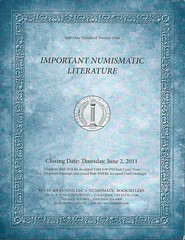 Kolbe & Fanning Numismatic Booksellers are pleased to announce the results of their 121st sale, which closed on June 2, 2011. It was one of the firm's largest and most diverse sale offerings in several years. The estimates of the 1576 lots in the catalogue totaled $165,000; the sale, including the buyer premium, brought over $179,000.
Kolbe & Fanning Numismatic Booksellers are pleased to announce the results of their 121st sale, which closed on June 2, 2011. It was one of the firm's largest and most diverse sale offerings in several years. The estimates of the 1576 lots in the catalogue totaled $165,000; the sale, including the buyer premium, brought over $179,000.
The sale started off with the second part of the Alan Luedeking library. The highlights of the Luedeking library were sold for generally quite strong prices this January in New York City by Kolbe & Fanning. Formed with great care and persistence over many years, the second sale of this remarkable library featured over 700 additional lots of works mainly on Latin American numismatics, some quite rare. Many items had never been offered for sale by Kolbe & Fanning or, at least, not in many years, and bidding was intense.
Luedeking's comprehensive, often complete, runs of sale catalogues and periodicals were avidly competed for, as were many rare and obscure specialized monographs. Some highlights follow: a complete run of 48 Asociación Numismática Española (A.N.E.) auction sales, 1955–92, were estimated at $400 but sold for $2,070 (prices quoted include the 15% buyer premium); a large lot of 180 auction catalogues and fixed price lists featuring Latin American coins and paper money was the focus of heavy bidding, selling for $1,725 on a $500 estimate; Maury Bromsen's 1960 tribute to José Medina sold for $276; a lot of 17 pamphlets on Central American numismatics, estimated at $70, realized $374; a featured lot was Jorge Ferrari's 1976 monograph on the 1828 Vauxhall token, along with a nice example of the token itself, was estimated at $500 and brought $1,322; estimated at $750, a complete set of Freeman Craig fixed price lists and auction sale catalogues along with a later-produced "complete list of prices realized" sold for $1,437; a second example, in lesser condition, of the fabled 1908 catalogue of the Gonzalez collection of Chilean brought $1,265 on a $1,500 estimate (the leather-bound January sale example realized $3,220); and Rosa's large-format 1904 work on early Latin American medals realized $1,265 on a $750 estimate.
Following the remainder of the Luedeking library, nearly 200 additional lots from the Dr. Ira Rezak library were featured in the sale, including a number of seldom-seen works on Russian coins and medals. Highlights from the Rezak library produced extremely strong results in the January 2011 New Sale and the trend continued in this second offering. Auction sale catalogues featuring Russian coins and medals were in great demand: a lot of six American and European sales were estimated at $100 but realized $345; an unplated example of the 1950 Christie's George Michailovitch sale catalogue, handpriced, sold for $374 and another annotated unplated copy brought $356, estimated respectively at $75 and $50. Estimated at $500, Ira Rezak's research files on Russian numismatics were a highlight, selling for $1,265. A complete set of the Journal of the Russian Numismatic Society, 1979–2010, so ably edited by Randolph Zander in the earlier years and currently by Robert Julian, was another high point, bringing $920 on a $500 estimate.
The remaining 650 lots, the property of well over a dozen consignors, covered the numismatic spectrum. Some highlights include: a plated example of the 1929 Thomas Elder sale of the George Alfred Lawrence realized $2,875 on $2,250 estimate; an exceptionally well-preserved example of Snowden's 1861 classic on Washington medals sold for $1,552; a fine original 1875 Crosby opus on American colonial coins, with the rare 1873 title and introduction, went for $3,105; a nice example of Strigerwalt's little 1884 Illustrated History of United States Coins had an estimate of $300 but sold for $$575; the first three Pridmore volumes on British Commonwealth coins realized $489 though estimated at $200; an interesting volume containing fifteen priced W.E. Woodward sales issued on thick paper brought $1,552; a substantial run of The Numismatic Chronicle, 1881–2004, was estimated at $6,000 and realized $5,635; a very rare 1861 flyer promoting a lottery scheme by Augustus B. Sage of coins, medals and tokens realized $1,610 on a $350 estimate; and an original 1863 San Francisco Mint payroll document confirming the employment there of author Brett Harte brought $920.
A few printed catalogues are still available and may be obtained by sending $10 to: KOLBE & FANNING NUMISMATIC BOOKSELLERS LLC, 141 W JOHNSTOWN ROAD, GAHANNA OH 43230-2700. On January 7, 2012, Kolbe & Fanning will be holding a public auction at the Waldorf-Astoria hotel in conjunction with the New York International Numismatic Convention. Consignments of exceptional numismatic works are now being accepted. Inquiries may be directed to David F. Fanning at df@numislit.com, (614) 414-0855, or to George F. Kolbe at gfk@numislit.com, (909) 338-6527.
NEW BOOK: WHAT ARE DIE VARIETIES? AN E-BOOK BY JAMES WILES
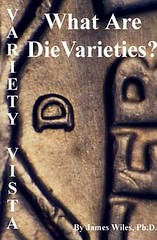 How long have you been waiting, longing, for a simple, yet elegant way to explain die varieties? Your wait is over. This new E-Book by Dr. James Wiles provides a clear explanation of die varieties, including their definitions, classifications, history, and pricing schemes. Over 6000 photos tell the story, making this E-Book the most comprehensive work on die varieties to date.
How long have you been waiting, longing, for a simple, yet elegant way to explain die varieties? Your wait is over. This new E-Book by Dr. James Wiles provides a clear explanation of die varieties, including their definitions, classifications, history, and pricing schemes. Over 6000 photos tell the story, making this E-Book the most comprehensive work on die varieties to date.
What will you find in the What Are Die Varieties? E-book?
- An overview of the entire die variety field, including design changes, mintmark styles, doubled dies, and repunched mintmarks. Such a complete work has never before been available to collectors.
- Exhaustive lists of many known die variety categories, such as over-mintmarks, inverted RPMs, Class III doubled dies, and many more. Each variety is not only listed, but is given detailed photographic coverage.
- All known U.S. mint set varieties. This feature is sure to be popular with collectors because nowhere else can you find such a thorough, comprehensive list. Each mint set variety has been meticulously photographed to reveal every detail.
- A cherrypicker's playbook. In other words, all the categories to look for and many of the most significant twentieth century varieties are included. With 6000+ photographs and 400+ varieties, there is something here for every collector!
- A complete and easily referenced introduction to all of the Variety Vista die variety attribution guides. Thus if you want an overview of the field, this is the place to start. Or if you need to brush up on the technical language or refresh your mind on the minting process, it is all here ready for your review.
If you have friends, colleagues, even customers who want to learn about die varieties, What Are Die Varieties? will get them started and will continue to educate them as they grow in the hobby. We have taken the breadth of an overview and added the depth of research to produce a must have volume. You will find many extensive lists, most exhaustive, and all fully illustrated. You will find new varieties never before published as well as fresh presentations of your old favorites. There is something here for everyone. No matter what your level of expertise, you will find yourself referring back to this book over and over.
And best of all, it's still just $30 + $4 shipping and handling. At that price why not buy two, one for you and one for a friend. Check out the Book Store on www.varietyvista.com for additional E-Books and discounts. You can send check or MO (payable to James Wiles) to 1490 Trail View Lane, Frisco, TX 75034 OR You can Paypal the monies to me at jameswiles@sbcglobal.net.
For more information, see: www.varietyvista.com
BOOK REVIEW: STRIKE IT RICH WITH POCKET CHANGE, 3RD EDITION
 Strike It Rich – With Pocket Change – Error Coins Bring Big Money, 3rd Edition by Ken Potter and Dr. Brian Allen is an inexpensive reference which will get everyone looking through their change for that scarce coin that will be worth hundreds, if not thousands of dollars in profit. We know that other coin books on error coins have been written, and we have some of them in our library. This soft cover book has 352 pages that contain many illustrations of just about every modern error coin that can make you money. The enlargement of the illustrations makes it very easy to see the error on the coin(s). All the illustrations are in black and white. As the book states, "There is no need for previous knowledge to get started."
Strike It Rich – With Pocket Change – Error Coins Bring Big Money, 3rd Edition by Ken Potter and Dr. Brian Allen is an inexpensive reference which will get everyone looking through their change for that scarce coin that will be worth hundreds, if not thousands of dollars in profit. We know that other coin books on error coins have been written, and we have some of them in our library. This soft cover book has 352 pages that contain many illustrations of just about every modern error coin that can make you money. The enlargement of the illustrations makes it very easy to see the error on the coin(s). All the illustrations are in black and white. As the book states, "There is no need for previous knowledge to get started."
When you open up the cover of the book, you cannot miss in the lower left the words "No Experience Needed." These are key words because the book is so well written that you can open it up to any page and find great information on some coin that you probably knew nothing about. Go to page 116 in the book, and it has information on, The "Perfect" Circulation Strike which shows a 2003 Lincoln Cent in MS-70 Red which sold in a Teletrade Auction for $13,500. The authors state that the chance of finding a "perfect" coin in circulation is remote. They tell the reader to "Look at: Uncirculated Coinage, especially "Bank Wrapped" rolls." Look for: High grade examples."
The well done Foreword by John Wexler lets you know that, "By becoming familiar with the contents of this book you may soon be finding some truly valuable coins for face value." We wholeheartedly agree with this quote and recommend this reference for beginning collectors, advanced collectors, coin dealers and treasure hunters. Both of these authors are experts and well known leaders in the field of error coins. Ken Potter has a web page which is updated with new discoveries and absolutely full of interesting information about error coins. http://koinpro.tripod.com.
The Table of Contents is the nuts and bolts of this publication. If you recently purchased this book you can go immediately to the page(s) containing the coin you think might be something special. If you have a coin that isn't listed, you truly might have something that will be very valuable. You will find coins listed from 1959 to 2009 including information on the 50 State Quarters (1999 - 2009), and the U. S. Presidential Coin Program. You will find a lot of useful information regarding just what error coins are.
We liked the Chapter on, "Valuable vs. Other Forms of Doubling." The seven pages containing this information will be all you will ever need if you wondered just what doubling on a coin meant. "Planchet Errors and Varieties," is another Chapter in the book that will explain in excellent detail information regarding these errors. If you find an error coin, the Chapter on, "Buying and Selling Error, Variety Coins," contains 15 pages of information. You will find all the sources that will help you dispense of, or find more information regarding the coin you wish to sell.
You will also find applications to join the American Numismatic Association - ANA – www.money.org, Combined Organizations of Numismatic Error Collectors of America - CONECA – www.conecaonline.org, and the National Collectors Association of Die Doubling - NCADD – www.ncadd98.org. Following this Chapter, you will find information regarding, Myths About Various Coins. It starts out with the Wheat Cent, including the 1943 Varieties. A quote in the book is "Age Does Not Always Equal Value," is certainly true in several areas, especially when it comes to the Wheat Cent. They have been replaced over 50 years ago with the Memorial Cent. Today, it would be very difficult to find a bag of Wheat Cents that haven't been searched, "numerous times."
Following the Wheat Cent are the Bicentennial Coins, Susan B. Anthony Dollars, Double Headed (usually a Quarter) Coin, Common Novelties (Coins that have added engravings such as a State outline and Presidential face) and finishing with Coins with No Mintmarks. Some "Common Currency Questions" and how to find a "Web Note" is also contained in this reference. The information on "Circulating Silver Coinage" will be useful to the beginning collector. Information on "Tissue Overlay" detection of Silver Coins was very interesting and will show you how to detect 1965 Washington Quarters that were struck on a silver blank.
The one page information on the Estimated Silver-Coinage Value Chart (provided by Krause Publications), will give you values of the Jefferson War Nickel, Roosevelt Dime, Washington Quarter, Kennedy Half (90% and 40% Silver). You can quickly see the prices per ounce from $5.50 to $15.50. These figures are very low today. Hopefully a 4th Edition will contain values up to $50.
"Coin Terms And Definitions," the "Bibliography," "Recommended Reading" and a page on "Final Tips" finishes out the book and we like the quote, "Perseverance is the key to Strike it Rich with Pocket Change. We like the famous quote, "A Fool and His Money Are Soon Parted." If perchance you pass on a rare coin to someone, and they later tell you about it, you will shake your head and wonder why you didn't look at the coin before passing it on. Al Jolson sang the song, "Brother Can You Spare A Dime," which had become popular during the Great Depression. Who knows, the dime that was given to someone during the depression could have been a rare date or variety. Today, you could pass on a rare dime or other coin to someone and later find out about it. A little knowledge would have prevented this from happening.
All the Chapters in the book are interesting and fun to read. Numismatic education is power, and if you read only a small part of this book it can help you to make money in an area you never thought possible. These authors have hit the jackpot and authored a reference that will help everyone in their knowledge and pursuit of error coins. It is a super bargain at the retail price of $19.99 (it recently was reduced to $13.59) from the publisher at: Krause Publications, a division of F + W Media, Inc., 700 East State Street, Iola, WI 54990-0001, (715) 445-2214 or (888) 457-2873 or visit www.krausebooks.com
BOOK REVIEW: THE MAN WHO LOVED BOOKS TOO MUCH
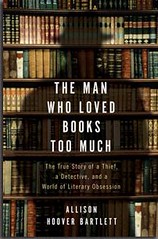 By chance I picked up a copy of "The Man Who Loved Books Too Much," which George Fuld mentioned in the 2010 Esylum. The book detail the exploits of John Gilkey, a rare book thief who will do pretty much anything to pilfer a book. Libraries and dealers alike, beware! He steals, gets caught and prosecuted, only to steal again after his sentence is served. The author, Allison Hoover Bartlett, leaves us little assurance that the cycle will ever be broken.
By chance I picked up a copy of "The Man Who Loved Books Too Much," which George Fuld mentioned in the 2010 Esylum. The book detail the exploits of John Gilkey, a rare book thief who will do pretty much anything to pilfer a book. Libraries and dealers alike, beware! He steals, gets caught and prosecuted, only to steal again after his sentence is served. The author, Allison Hoover Bartlett, leaves us little assurance that the cycle will ever be broken.
Bartlett's point of view reminded me a lot of Alison Frankel's book on the 1933 double eagle - bringing an outside journalist's eye to what is primary a middle-aged male endeavor. Book collectors, it turns out, like coin collectors, tend to be older males. As such, the book is a little bit painful to read - she has no axe to grind with the collector per se, but she is telling it like she sees it. The scary part is that most collectors will see a bit of themselves in Gilkey, who she thoroughly dissects over a series of interviews.
The primary source material is the author's extensive interviews with Gilkey and Ken Sanders, a rare book dealer responsible for bringing Gilkey to justice. Bartlett made the decision early on to inject herself as a character into the book - perhaps self indulgent in some situations, but necessary in this one. She develops a relationship with Gilkey over a period of years, and if she doesn't amplify the reader will be left curious.
As my wife, not a numismatist, tells me, the story behind my books ought to be a book itself. The book is a quick read (not sure why the publisher chose to double space it, perhaps to help justify the cover price) and with used copies on Amazon starting at $2, is a no-brainer for all of us who love books too much.
Inside Brick Row, natural light streamed through the windows, illuminating books sitting in cases along every wall and under windows, and on a graceful arc of shelves that ran through the middle of the shop. It was a quiet refuge from the city streets below, and if you ignored the computer and phone on Crichton's heavy, oak desk, it could be a nineteenth-century bookshop. Thousands of majestic leather-bound books, many with gold lettering, caught the light as I walked by. Given Gilkey's Victorian library fantasies, I could see why he favored this shop, why he chose to bring me there.
To visit the author's web site, see: www.allisonhooverbartlett.com/book.html
"AMERICA'S BEAUTIFUL NATIONAL PARKS"
SPINK DIRECTOR PAUL DAWSON INJURED IN AUTO ACCIDENT
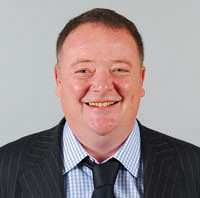 Paul Dawson, director of Spink and long time highly respected coin dealer had a very serious car accident on Thursday night. He hit a lorry on the M1 motorway and is in hospital in a most serious way. His partner who was passenger, has died.
Paul Dawson, director of Spink and long time highly respected coin dealer had a very serious car accident on Thursday night. He hit a lorry on the M1 motorway and is in hospital in a most serious way. His partner who was passenger, has died.
Brian Dawson (Paul's dad) phoned me Monday morning and is content to have the following information put out amongst the numismatic fraternity:
Paul is alive but on life support and unconscious. His spinal cord may or may not be OK. The most senior surgeon's words were "it is down to time and in the hands of the Gods". He has had brain surgery. Paul is in the best possible hospital for the situation, specialising in just this sort of problem.
REMEMBERING NBS MEMBER GEORGE FITZGERALD
Roger Urce writes:
I have been informed by Bill Haines of the passing of George Fitzgerald of Fort Wayne, Indiana. Apparently George passed away over the Memorial Day weekend.
Joel Orosz writes:
I remember George attending many NBS meetings over the years.. I had only a couple of brief conversations with him , The thing I remember best about him was his trademark baseball-style cap. In fact, I can't recall ever seeing him without it.
Pete Smith writes:
George Fitzgerald was a great sports fan. I don't think he made all of them but he attended many of the recent Olympic Games around the world. He had already put down a deposit to go to London for the next Olympics.
He played golf and occasionally went as a spectator to Atlanta for the Master's golf tournament. I heard a story this week that around his 70th birthday he played 70 holes of golf in one day. That is an accomplishment that gets tougher each year.
George participated in a sub-culture in numismatics built around Bureau of Engraving and Printing (BEP) souvenir cards. During an ANA convention the BEP may hold drawings to sell pulled proofs of these cards. People who don't collect them will still enter the drawing. With cards that cost $50, there is an immediate secondary market of dealers offering $75 or more.
We had mutual friends in the Souvenir Card Collecting Society. Our group roomed together and had dinner together at Central States and ANA conventions.
I attended the 2005 ANA convention in Las Vegas where the BEP had their typical exhibit. George was one of a few people there without a table. With low public attendance, it was quickly apparent that there would be more cards than public interest. Many dealers with tables close to the drawing signed up. My co-worker won on the first day and I won on the second. Ken Barr was buying up cards for his clients. George was also there buying cards for his circle of friends. They were quickly able to fill their want lists and prices dropped.
Dealers with tables at the show got a nice steak dinner at Smith & Wollensky and two tickets to a basketball game at UNLV. My co-worker was not interested in going so I asked George to join me as my guest. He was happy for the offer as he had not previously seen a game at the Thomas and Mack Center. In a pre-season exhibition, The Lakers beat the Kings 105-103.
George was a good talker and not shy in talking about himself. In general, this was not boastful. He told interesting stories because he did interesting things.
He would spend what was needed to go to the Olympics but preferred inexpensive travel in this country. In contrast, he leased a Mercedes and just recently picked up a new model.
George worked as a sales representative for ITT before retirement. Friends believe that he had no children and never married.
The Allen County Public Library in Fort Wayne has a well-known genealogy collection. George worked there as a volunteer. In semi-retirement, he also worked part time for Fairfield Rare Coins.
I last saw George at the recent Central States show in Chicago. Among other activities, he was judging exhibits. At the time he appeared in normal good health.
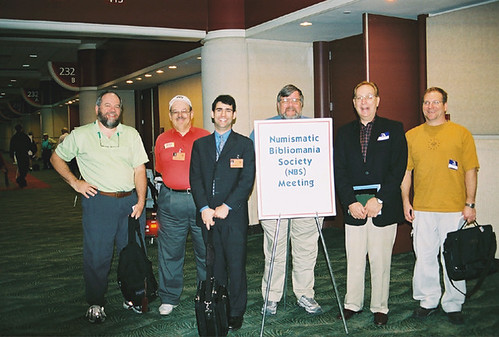
1. Craig Eberhart (wearing light green shirt)
2. George Fitzgerald (wearing a red shirt)
3. John Kraljevich (wearing a suit)
4. Wendell Wolka (behind sign)
5. Dan Hamelberg (wearing dark jacket)
6. Jeff Reichenberger (wearing a yellow shirt)
I adapted the following from a remembrance of George by Fred Schwan in the June 8th, 2011 issue of MPC Gram, a blog for collectors of Military Payment Certificates and other forms of military money.:
George Fitzgerald was a GREAT collector. I am sure that he would like to be remembered for that and of course he will. He was also a gentleman and good guy.
In numismatics he had very wide and diverse interests. I am sure that I only know of a few of the interests. He had an advanced MPC replacement collection. In other paper money he collected Fort Wayne, Indiana national bank notes.
In United States coins, he really liked half dimes, but collected many series. Indeed, many different series were collected and put away many years ago when he completed them or lost interest in favor of something else.
He had an advanced collection of Lesher dollars which he dearly liked and researched avidly. Like many advanced collectors, he really appreciated numismatic books, both his own and those in libraries.
George was a great supporter of the ANA. I suspect that he attended more than 50 summer conventions and possibly all of the winter events (called by various names over the years).
My favorite story about George concerns a prized national bank note in his collection. I have told the story many times in the presence of George. It is a $2 national. They are affectionately known as you probably know as Lazy Deuces. The note in question of course was on a Fort Wayne bank. At the time it was the only deuce known on Fort Wayne. Indeed, until a few hours before the story starts, it might not have been known in any collections.
We were at a show. I had a bourse table. George was walking the show. He found this important note. Frankly, it was a dog, but boy did it look good to a Fort Wayne collector. The rub was the price. The dealer wanted a price that George just would not pay.
I encouraged, pushed, begged, and otherwise tried to talk George into buying it, but he refused. When he left the show on Saturday afternoon, I went over and bought it! I knew that he would regret not having bought it, because I have been in that situation just too many times.
Well, as it happened within a few months George found a note that I wanted so I produced the deuce and eventually we worked it out. It gets better. At the next MPC Fest Bill Haines told me that not only did George show the note at the local (Fort Wayne) club, but he also took it to every meeting!
I liked to razz George a little about the deuce. He not only took it in good nature, but told me something important that I believe applies to all of us. He said that I had taught him something by the deuce episode--that a collector should not pass up something important because of a few dollars (of course the definition of few comes into play). Anyway, I was flattered by what he said and will always remember that.
George and I were both fans of the Olympics. I like to talk about the many hours of being glued to the television watching intently for the past 30 or more years. George and I could talk about certain really important Olympic moments. Millions and millions of people feel and talk the way they do about the Olympics. But only a few from George's point of view. Those many Olympics that I so happily watched on television, George watched in person!
Of course he was able to combine Olympics and numismatics with a collection of participation medals (and perhaps some award medals--I am not sure).
He attended many other big name sports events too. He had albums full of the tickets to these many events--imagine that, he collected the tickets. George himself was a avid golfer. That is where he left me behind. I would be a danger on the course, but he had played a round with many collectors. George, you were and will continue to be an inspiration. Thank you.
NUMISMATISTS ATTEND SERVICES FOR PUBLISHER AL HOCH
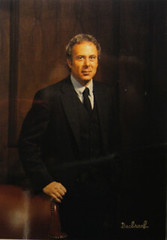 On May 21, I attended a memorial service in honor of Al Hoch. After 10 days of rain, the skies parted and you could not ask for a more beautiful day. There were about 50 who gathered at the Old Cemetery in Lincoln Massachusetts to pay tribute to the man who had such a profound impact on colonial numismatics and numismatic publishing but who shunned the limelight and the accolades he was due. Loving stories and reminiscences were delivered by his three sons and daughter, but I will say the most touching was his 13 year grandson talking about how he researched a colonial note using a book sent to him by Eric Newman.
On May 21, I attended a memorial service in honor of Al Hoch. After 10 days of rain, the skies parted and you could not ask for a more beautiful day. There were about 50 who gathered at the Old Cemetery in Lincoln Massachusetts to pay tribute to the man who had such a profound impact on colonial numismatics and numismatic publishing but who shunned the limelight and the accolades he was due. Loving stories and reminiscences were delivered by his three sons and daughter, but I will say the most touching was his 13 year grandson talking about how he researched a colonial note using a book sent to him by Eric Newman.
The numismatic contingent consisted of just myself and Edmund Sullivan whom I met for the first time. After the service, we were invited back to David Hoch's home for a reception where many photos and memorabilia were displayed. The first thing I spotted in the foyer was the Aaron Feldman plaque that I had placed in Al's hands 19 years ago at the Numismatic Bibliomania Society meeting at the Orlando ANA convention. It obviously had meant more to Al than just another piece of wood and bronze.
Invitations to the service included a reproduction of a handsome portrait taken by Bachrach Studios. In an article published in The World in 1993, the writer makes the comment that "for 125 years it has been the sine qua non of celebrityhood that one have one's portrait done under the Bachrach label. Every United States president since Andrew Johnson has sat for a Bachrach photograph and still today, public figures include a stop at Bachrach Studios among their most important appointments." I would not deny that Al belongs in that circle.
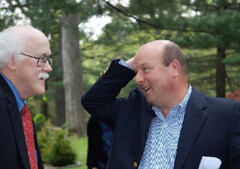

To read the earlier E=Sylum article, see: NUMISMATIC PUBLISHER AL HOCH, 1935-2010 (www.coinbooks.org/esylum_v13n48a02.html)
SALE 13 IS NOW CLOSED
A HEARTY THANK YOU! TO ALL OURBIDDERS AND CONSIGNORS
PRICES REALIZED ARE POSTED ON OUR WEB SITE NOW!
PLEASE CHECK OUR WEB SITE FOR HIGHLIGHTS OF OUR NEXT SALE
OCTOBER 1, 2011 - MAIL BID SALE NO. 14
DAVID SKLOW – FINE NUMISMATIC BOOKS
P.O. BOX 6321
COLORADO SPRINGS, CO 80934
TEL: (719) 302-5686
FAX: (719) 302-4933
numismaticbooks@aol.com
www.finenumismaticbooks.com
FIRST DENVER MINT CHECK HOARD DISCOVERED
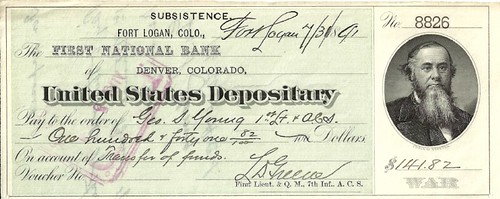
A horde of several hundred federal bank checks and documents from the first branch Mint in Denver has been found in a private Colorado collection. According to numismatic researcher Dr. Lawrence J. Lee, the document collection includes letters, stock certificates and pre-Territorial records, as well as U.S. Quartermaster and Paymaster checks issued by the Federal government for payment of debts, salaries and expenses in the Rocky Mountain region prior to 1900. The horde include hundreds of checks issued by the United States Branch Mint at Denver, Colorado, the so-called "first Denver mint," which existed from 1863-1905.
Most official U.S. government checks of the early Colorado period were drawn on the First National Bank of Denver, the only Federal depository in the region. Several different main check styles were used, with many minor variations. Most Treasury checks are printed on specially watermarked U.S. Treasury Department paper and have an image of Secretary of War Edwin Stanton on the right side. The word "WAR" is printed in the lower right corner. This style of check was adopted by the U.S. Treasury soon after the Civil War commenced and was apparently continually used until at least the early 1900s.
The checks issued by the Denver Mint are signed by the ‘Assayer in Charge' and cover the period 1865-1899. Clark, Gruber Bank & Mint and its successor, the First National Bank of Denver, dominated banking in the western United States from its inception in 1860 to merger in the mid-1980s. The Clark, Gruber minting function was purchased by the U.S. government in 1863 and survives today as the United States Branch Mint at Denver.
The First National Bank had an extensive document archive that was broken up thirty years ago, with much of the collection going to the Colorado State Historical Society. Dr. Lee discovered and has control over a substantial and important portion of the bank and mint archives that remains in private hands. In the course of researching the first Denver Mint, Lee examined images of documents from the National Archives in Washington, D.C. and viewed the contents of the Mint archives located at the Denver Federal Center on multiple occasions. Leads from that research led Lee to the family with the private collection.
Depository (depositary) checks were drawn on government funds at certain, specially designated, nationally charted commercial banks. The checks drawn on the FNB-Denver in the last quarter of the 1800s were from the Denver Assayers Office of the U.S. Branch Mint in Denver. Other checks in the collection were used to pay units on military posts, Indian agencies and other government entities. The cache of U.S. Mint checks represents a huge research project that will take some time to adequately explore and catalog, said Lee. "These checks contain a perfect record of the activities of the U.S. Mint during a time when virtually nothing is known of its day-to-day operations."
He noted that in some cases, the Mint is cutting a check to a miner who has brought in raw gold to be sold to the Mint. The check lists not only the name of the miner and the amount of gold and silver contained in his ‘poke,' but also lists the name of the claim from where the gold was mined. Checks are also made to Mint employees, providing a list of names, positions and pay scales. "This is invaluable information," said Lee. "It looks to me like someone's PhD. dissertation waiting to be written."
For more information about the Denver Mint checks, email Dr. Lawrence J. Lee at lee@athena.csdco.com or write him at P.O. Box 6194, Lincoln, NE 68506.

A NEW CALIFORNIA GOLD CONTROVERSY: GOLD NUGGET LIKELY FROM AUSTRALIA
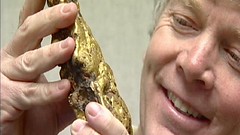 A gold nugget that sold at auction for $460,000 in March may, it turns out, actually be from Australia -- not California's gold country.
A gold nugget that sold at auction for $460,000 in March may, it turns out, actually be from Australia -- not California's gold country.
Fred Holabird, the auctioneer who sold the 98-ounce nugget in March to an unidentified buyer, had been convinced the nugget was from California's Gold Rush era.
But two prospectors from Australia, Murray Cox and Reg Wilson, who saw a photo of the nugget in a news report, say it shows an uncanny resemblance to the gold they found in a farm field in Victoria, Australia, in 1987.
"Instantly I knew it was the nugget that Reg and I discovered at Rokewood," Murray Cox told the ABC affiliate in Sacramento, KXTV.
A photo of the Australians' nugget from a newspaper article in 1987 shows their nugget has a similar shape to the auctioned one - and shares the same weight.
Cox told KXTV that he sold the nugget to an American gold dealer in 1989.
Holabird said the landowner in Nevada County, Calif., who provided the nugget, is sticking to his story that it came from his property in the Sierra Nevada mountains.
But the auctioneer is assembling a team of experts to investigate the Australians' claims. Holabird, who had been in the mining industry for over 25 years, owns Holabird-Kagin Americana, an auction business based in Reno, Nev.
"We're going to pursue this full tilt using the best science available," Holabird said.
To read the complete article, see: Gold Rush Mystery: War Over $460,000 Gold Nugget's Origin (abcnews.go.com/Business/battle-460000-gold-rush-era-gold-nugget/story?id=13785273)
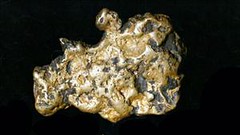 The giant gold nugget is real, but the story of how it went to auction in Sacramento is full of giant holes.
The giant gold nugget is real, but the story of how it went to auction in Sacramento is full of giant holes.
James Saunders Grill reported finding the 98-ounce nugget last year on his property along the South Fork of the Yuba River in the Gold Rush-era mining town of Washington.
After the discovery, a Website appeared seeking investors to help develop a commercial mining operation called the Lost Scotchman Mine on the 180-acre property, suggesting the giant nugget was just the "tip of the iceberg."
"Act now and just like the 49ers of 160 years ago, you can experience the wealth and excitement of the Gold Rush," the Website encouraged prospective investors.
The property is landlocked, and federal court documents show Grill, 70, has been involved in a long-running legal battle with the United States Forest Service to gain road access.
What became known as the Washington Nugget fetched $460,000 at a Sacramento Convention Center auction March 16, and the well-publicized event helped lead to the unraveling of the story.
The Arizona gold dealer, colorfully known as Rattlesnake John, later used an image of the Australian nugget on his business cards.
Fred Holabird, the Reno auctioneer who sold the nugget in Sacramento, said he was convinced it came from Northern California because it had the same appearance as others from the area. It also came with a signed affidavit from Grill attesting to its authenticity.
"I got taken as bad as anyone," Holabird admitted.
Holabird said he was surprised that no one recognized the nugget while it was on public display for three months prior to the auction.
Holabird has offered to pay for scientific testing to verify the nugget's origin, but hoped to avoid the expense and wasted time by encouraging Grill to come forward to explain what happened.
To read the complete article, see: Famous California nugget came from Australia (www.news10.net/news/article/140854/2/Landowner-identified-in-giant-gold-nugget-hoax)
"FERRACUTE GOES TO CHINA" EXHIBIT SHOWS MINTING TECHNOLOGY
On December 27, 1897, Ferracute Machine Company engineer Henry Janvier left Bridgeton to bring the technology to press coins to China, a completely foreign world to New Jerseyans at the time.
He successfully returned here 10 months later with international repute for Ferracute, quite literally putting Bridgeton on the globe.
On Saturday, June 25, this remarkable history will come to life at the opening reception for a long-awaited exhibit titled, "Ferracute Goes to China" at Frank Burton & Sons, 333 W. Broad St.
"The exhibit includes more than 30 photographs by Henry Janvier and (Janvier's friend) Sydney Bowen, many that have never been published before. Janvier and Bowen traveled from Philadelphia to San Francisco and across the Pacific, to Japan and to Shanghai, China together documenting the trip with their cameras," said Joan McAllister, one of several volunteers at Burton's showroom who have been researching, planning and uncovering old photographs through an across-country search for over six months.
Janvier's trip to, throughout and from China was well-documented through his photos, reports to Ferracute Machine Company, letters sent home over the 10-month expedition and articles in the Bridgeton Evening News.
"The Ferracute received an order through our agency, the American Trading Company, of New York, for a complete minting outfit for the city of Chentu (sic), in the province of Szechuan, China," Janvier recalled to the Bridgeton Evening News for a first-person account published on December 10, 1939.
"I was called upon to help with the design of this plant, which was to be a complete factory for the making of money, in reality a miniature of the great United States Mint in Philadelphia."
The Chinese government sought modern coining presses to replace the country's ancient system of pouring molten metal into molds for production of small-denomination brass coins known as tsen or "cash" to foreigners, as well as silver coins in denominations similar to American money.
In addition to the coin presses themselves, the extensive equipment necessary to operate a mint was prepared in the United States and shipped along with blueprints to arrive prior to the arrival of the Ferracute engineer.
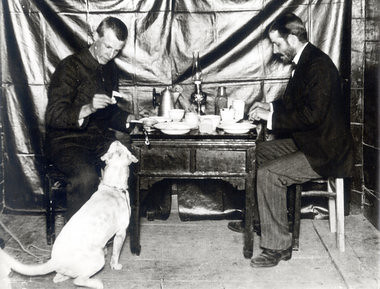
Henry Janvier and his interpreter Henry Everall on a boat with their dog, Snooks.
Making his way to Szechuan, Janvier traveled through perilous weather by boat for weeks, picking up his interpreter, companion and assistant Henry Everall, an English employee of the American Trading Company, in Shanghai. The duo, without an already travel-weary Bowen, was transported by steamer up the Yangtze River from Ichang to Waushin.
Janvier, Everall and their dog, nicknamed "Snooks," were then carried by Chinese laborers in sedan chairs for 40 miles a day, all without seeing any wheeled vehicles. When they arrived in Chengdu, a city populated with 700,000 people and 10 words of English among them, they discovered the equipment shipped from Bridgeton had been unloaded at a low river stage and nearly ruined when the water rose.
By summer, the equipment was ready for operation, and despite the blemishes caused by the corroded components, Janvier reported the coins "were received by the Chinese officials with almost childish delight."
Janvier noted in his News account, "Everall told me the Mandarin passed his finger over one of the small blisters on the dragon's tail and observed how nicely those extra marks would prevent counterfeiting!"
More information on the "Ferracute Goes to China" exhibit and Ferracute Machine Company history is available online at www.oberlinsmith.org.
The website also features a chapter on Janvier's trip to China from Art Cox's book, "Ferracute: The History of an American Enterprise," which will be available for sale at the June 25 reception along with a newly printed set of souvenir photograph postcards commemorating one of Bridgeton's most unique tales.
To read the complete article, see: "Ferracute Goes to China" exhibit to show Bridgeton history, delivery of mint technology to Far East (www.nj.com/cumberland/index.ssf/2011/06/ferracute_goes_to_china_exhibi.html)
ANOTHER RATS OF TOBRUK MEDAL
Web site visitor Col Cadman writes:
I have a little to add to the medal made by the soldiers. My father was a "RAT"in the 13th Field Co. I still have his medal (see attachment)which is numbered 500.
The first letter of the serial number indicates the state they enlisted. In my father's case it was Queensland hence QX and FP Bingham would have enlisted in Tasmania. My father, who died in the sixties, like most in that time spoke little of his time in Tobruk. However, I do remember him saying that this was not his original medal. He said he had some involvement in the making of the medal and originally had one of the early numbered medals. Damian Lewis's reference to the field engineers making the medal, gives some credibility to my father's account, as he was a Sapper in the field engineers.
The medal is a very treasured item for me, and I am pleased to see article recording some of the history of the unofficial medal.
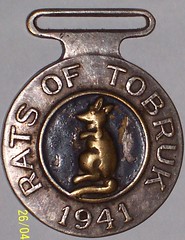
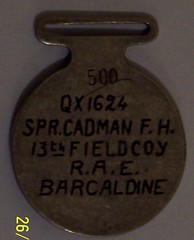

To read the earlier E-Sylum article, see: More on the Rats of Tobruk Medal (www.coinbooks.org/esylum_v14n16a13.html)
NOTES FROM E-SYLUM READERS: JUNE 12, 2011
Last Week's Issue
Regarding last week's E-Sylum. Dave Bowers writes:
Really neat issue!
Eric Newman's Arm Candy
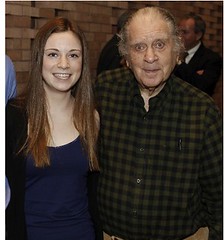 Regarding an image from a newspaper article about Eric Newman's visit to his old prep school, Pete Smith writes:
Regarding an image from a newspaper article about Eric Newman's visit to his old prep school, Pete Smith writes:
It was good to see the pictures of Eric Newman at age 100. His wife Evelyn was looking pretty good too. How old is she now?
Slabbing the 1794 Starred Reverse Cent
Regarding the recently discovered 1794 Starred Reverse Large Cent, Kerry Wetterstrom reports:
At a meeting of the Red Rose Coin Club, held right before the auction of this cent, someone stood up to make an announcement on behalf of the auctioneer (Wolfe). They said that it had been slabbed by PCGS, which several of us then commented that this would make it worth some "big bucks." However, this is just hearsay, as I did not actually attend the auction, and have not spoken with anyone that did. Perhaps PCGS could verify if they actually slabbed it or not?
I asked around, contacting friends at PCGS and NGC, but no one could confirm having seen one of these recently. Kerry asked around, too. He writes:
I spoke with Paul DeFelice at ANACS, and he confirmed that they did authenticate and slab the 1794 Starred Reverse Cent. He also said that Coin World did a story on it that will be published this week.
More on the Woodward & Lothrop Coin Department
Regarding the Woodward & Lothrop Coin Department, Ron Ward writes:
I first purchased coins from"Woodies" in Chevy Chase, Maryland in the mid-1960s. I believe their coin shop on the first floor was a franchise from the Coin & Currency Institute, best known for their book on "So-Called Dollars" . During this period, it was the best source in the suburban Maryland area for better foreign coins. I recall purchasing a number of older Chinese dollars and minor silver which I sold in 1998 in a Coin Galleries auction. The coins came in 2x2 paper envelopes with the data typed on the front and the price written in pencil on the bottom. The department was supervised by a lady who later retired and the operation was taken over by her assistant, Nelson. They were very helpful and at times would request specific material for me from New York.
Oops! Broken Link
George Corell pointed out a bad link in the article on states allowing silver coinage. Thanks! We've fixed it on our archive.
The correct link is here:
www.moneynews.com/StreetTalk/Gold-Silver-Legal-Currency/2011/05/27/id/398039
To read the earlier E-Sylum article, see: GOLD, SILVER BECOMING LEGAL CURRENCY IN MORE STATES (www.coinbooks.org/esylum_v14n23a14.html )
SellCoinBooks.com Not A Retail Site
Joe Boling writes:
The press release about sellcoinbooks.com says that "retail customers can find a wide range...." Sounds to me like this site is designed for wholesale customers, not retail customers. If they are talking about customers who will resell books at retail, they have a strange way of labeling same.
To read the earlier E-Sylum article, see: NEW WEB SITE: SELLCOINBOOKS.COM (www.coinbooks.org/esylum_v14n23a05.html)
Numismatic Periodical Offprints
Ralf Böpple of Stuttgart, Germany writes:
I have reorganized my library, and I came across a fair number of small pamphlets that are articles reprinted from numismatic publications such as The Numismatist. Apparently, this was frequent practice in past decades, but I did not see any reprints of later days. My question therefore: is it still practice today that offprints are made of articles of a certain importance? Who does, or did, decide if a special offprint is made?
Journals of the Continental Congress
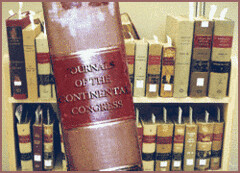 Ray Williams, past president of the Colonial Coin Collector's Club (C4) writes:
Ray Williams, past president of the Colonial Coin Collector's Club (C4) writes:
Jim Jones sent this website (Journals of the Continental Congress) to C4 online. It is really cool and has many players from our early coinage times documented.
To visit the web site, see: Journals of the Continental Congress (memory.loc.gov/ammem/amlaw/lwjc.html)
The July 2011 Baltimore Expo
Have you ever looked at a busy Bourse floor at a coin expo and wondered which of 1,000 dealers has the coins you want most? Finally, there's a solution, and it's making its debut at the Whitman Coin & Collectibles Baltimore Expo—June 16-19, 2011.
Whitman Compass™ is an innovative but easy-to-use new tool that helps collectors go straight to the dealers who have the coins or currency they're looking for right now. It's currently in Beta testing, but available for use at WhitmanCompass.com.
Other Expo highlights include
- The Stack's Bowers Galleries auction of rare coins and paper money
- The Presidential Coin & Antique Company's 81st Exonumia Sale features three major consignments — David H. Hirsch's Washingtonia collection, Ron Thompson's inaugural medals, and Estate of Steve Middleton's Columbian Exposition tokens and medals.
- The Liberty Seated Collector's Club, Maryland Token and Medal Society, and Early American Coppers Club are all meeting on Friday or Saturday. Consult the show program for details.
To read the complete press release, see: Whitman Compass™ Debuts at Baltimore Show (whitmancoincollecting.com/content/whitman-compass%E2%84%A2-debuts-at-baltimore-show/)
THE NUMISMATOURIST VISITS ITALY
The Numismatourist strikes again. This time I just returned from a trip to Milan, Genoa, Bologna and San Marino. Interestingly there were numismatic venues in all of these places.
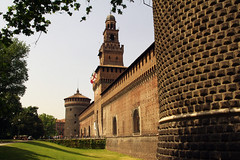 In Milan, one of the best known landmarks is the Sforza Castle (Castello Sforzesco), was built in its present form in the 16th century as part of the city wall and defense of Milan. It was also the residence of the Visconti and Sforza families that ruled Milan. Today it contains several museums along with a coin collection and a numismatic library. However, the coin collection (Gabinetto Numismatico del Comune di Milano - Numismatic Cabinet of the Municipality of Milan) is not open to the public, but can be viewed by appointment. You need to specify which area you are interested in (e.g., Hadrianus Imperial Coinage, or the mint of Milan). The Castle's Archeological Museum, located a few blocks from the Castle at Corso Magenta 15, has some Greek coins from the 2nd century A.D. that were found during excavations of the city.
In Milan, one of the best known landmarks is the Sforza Castle (Castello Sforzesco), was built in its present form in the 16th century as part of the city wall and defense of Milan. It was also the residence of the Visconti and Sforza families that ruled Milan. Today it contains several museums along with a coin collection and a numismatic library. However, the coin collection (Gabinetto Numismatico del Comune di Milano - Numismatic Cabinet of the Municipality of Milan) is not open to the public, but can be viewed by appointment. You need to specify which area you are interested in (e.g., Hadrianus Imperial Coinage, or the mint of Milan). The Castle's Archeological Museum, located a few blocks from the Castle at Corso Magenta 15, has some Greek coins from the 2nd century A.D. that were found during excavations of the city.
In Genoa, besides the having #1 tourist trap that features the house where Christopher Columbus grew up, it has the Palazzo Doria Tursi Museum, aka Genoa's town hall. They have a nice collection of ancient, Genoa and Ligurian coins in two of the rooms on the 3rd floor.
In Bologna, just off the Piazza Maggiore, there is the Archeological Museum, whose coin collection numbers about 100,00 specimens. Sadly, right now, when I spoke to the museum's curator, funding has prevented the museum from adequately displaying parts of the collection. The museum, hopes in the near future to be able to properly display their collection.
I had to take a 1-hour train ride from Bologna to Rimini, a town on the Adriatic, and then catch a bus to San Marino for another 45 or so minute ride. There were several reasons for going there. (1) Because it's there and it's a new country for me (#51 – I got the passport stamp to prove it and cost me 5 euro); (2) there were a few venues that have exhibits of coins that I wanted to see since I was "in the neighborhood;" (3) and I've been to 4 other micro European countries: Liechtenstein, Luxembourg, Vatican City, and Monaco. The only ones left I haven't been to is Andorra and Malta.
San Marino is the world's oldest republic, founded in 301 AD and it's constitution, enacted in 1600, is also the world's oldest. For such a small country, entirely surrounded by Italy, it sits on Mt. Tintano up about 2,500 feet, and it has two numismatic museums! One is located in the State Museum. Some coins are mixed with archeological exhibits on the first floor but the main numismatic exhibits are located in a room in the first floor underground. The other is the Coin and Stamp Museum under the aegis of the Autonomous State Agency for Philately and Numismatics (AASFN).
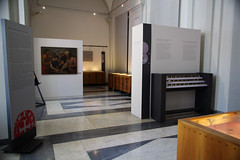

THE BOOK BAZARRE
MAN CHARGED IN THEFT OF RARE ALASKAN NATIONAL BANK NOTES
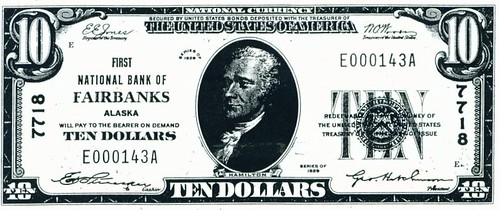
Fairbanks locksmith Forrest R. Holton was arrested Saturday by Fairbanks police on a charge of felony theft of national currency notes from the estate of the late William "Bill" Stroecker. The notes have an estimated value of $500,000.
The alleged theft dates to Dec. 29, 2010, when Holton was called to Key Bank in downtown Fairbanks by Stroecker's estate attorneys, Richard Hompesh and Matt Blattmachr. The key to the late banker's four safety deposit boxes could not be found and Holton was called in to drill the Diebold boxes open.
According to Don Dennis, spokesman for the Stroecker estate and foundation, the theft didn't come to the attorneys' attention until months later, when they were spotted on an auction site based in Dallas.
"These items are rare enough that a number of (local) people became aware of it before the estate was, and notified the estate," Dennis said.
Holton was identified as the person who sold 10 antique currency notes to the auction company on Jan. 26, for $82,000, and deposited the check on the same day into a personal account at Wells Fargo Bank.
Holton also was found to be negotiating a sale of another 30 to 40 notes with an East Coast currency dealer.
On Saturday, the police investigator met Holton at Fairbanks International Airport as he was returning from a combined vacation/work trip, and took him into custody.
Holton made a verbal and written confession that stated he stole a red cloth envelope containing the notes. He was escorted to his home, where the rest of the notes were recovered from a chest of drawers, and then to a rented storage unit where two uncut sheets of currency were secreted behind a photograph hanging on the wall. The uncut sheets were not initially reported as stolen, but they are estimated to be worth $250,000 together.
Stroecker, a banker for 60 years, was born in Fairbanks in 1920 and died here on Nov. 10.

To read the complete article, see:
Fairbanks locksmith charged in $500,000 theft from Stroecker estate
(www.newsminer.com/view/full_story/13302471/article-Fairbanks
-locksmith-charged-in--500-000-theft-from-Stroecker-estate-)
JOE FOSTER RECALLS FRANK KATEN
i wanted to share my experiences with Mr. Katen ( he was always Mister to me). I first met Mr and Mrs. Katen when I moved to Virginia in 1965. I started bidding with him when I was living in Waukegan, Illinois (where i went to high school and graduated in 1963).
I called him and was invited to his house (on New Hampshire Avenue , I believe) where he was doing business. I specialized in Canadian literature and US auction catalogs with Canadian content and collected Canadian tokens by Breton and Leroux numbers.
I remember my first visit well. I was met at the door by Mrs. Katen and was immediately offered coffee and then the offer to fix me breakfast!!!!!!!! I went down to the basement to look thru the bookstacks.
If I didn't have enough money, he let me pay him so much a month (it usually took me only a couple of weeks. I have been in construction all my life and was working as a union labor foreman for the wonderful sum of $2.10 per hour!!!!
A couple of years later he sold me a collection of Canadian tokens he had purchased, and let me pay for them over a 3 month period (there were many duplicates, some of which I sold in one of Frank Rose's coin sales. As i recall the price was 600.00 or thereabouts
I was also a regular visitor to his shop, which he opened up on Colesville road, i think. I attended both of the Fuld sales, buying the Canadian items and auction catalogs that Harry Bass wasn't interested in !!!!!!!!!!!!
i bid on the set of the American Journal of Numismatics, but was outbid by Al Hoch, i think, and he reprinted from it, i think. I later acquired the same set from Cal Wilson. As for Harry Bass, he was very generous and kind to me , taking me to lunch with Mr. and Mrs. Katen.
I also bid on the Chapman, Frossard and Low sales, but alas was outbid, even though by these sales i was now an assistant construction supt.!!!!!!!!!!!!!!!!!! Needless to say Mr. and Mrs. Katen were very kind to a young 20 year old and this continued until the last sales
I did buy most of the Canadian material i needed, as well as some of the medal books.
JOHN DANNREUTHER ON HARRY BASS
Harry Bass was a man whose passion was United States gold coins. Starting in 1966, he began assembling a gold coin collection that would eventually include over 6,000 coins. Not only did he collect by date and mintmark, he collected by die variety and die state! Besides being the most complete die-variety and die-state collection of United States gold coins ever assembled, Harry's collection is also the finest-condition set of all time!
Harry Bass also had an incredible numismatic library. (This treasure also is part of the Foundation.) He often bought entire collections to obtain one book he desired. His duplicate books and catalogs were sold by noted bibliophile George Fredrick Kolbe, who had to break the 50 plus boxes into four separate sales.
I did not know Mr. Bass as well as I wished. Most of his coin buying took place in the 1960s and 1970s; however, I do have one Harry Bass story of note. When the Eliasberg gold coins were sold in 1982 by Bowers and Ruddy, the collection was not directly identified as such. It was called The United States Gold Coin Collection. It was not really a secret to most numismatists whose collection was being sold (the collection had been on display several times, including the Philadelphia Mint during the bicentennial celebration in 1976).
I had the good fortune to be seated next to Harry Bass for two days of lot viewing for this event. Mr. Bass brought a great deal of his coin collection to New York City for this auction. He would examine a lot in the auction, then pull out his coin and compare the two. I initially thought he was looking for coins that were upgrades to his examples, but I soon realized he was comparing die varieties and die states! Although I had not written anything on die varieties at the time, I was interested in them and Harry soon realized this.
Mr. Bass always shared information and was, on occasion, a practical joker. We were discussing the 1854 Dahlonega three-dollar issue and I made a comment about how rare the coin is with full denticles. Harry said that he would bring his three-dollar collection the next day and he had one to show me.
The next morning, I took my seat at viewing and started examining more coins. At some point, Harry said, "Oh, here's the 1854-D three-dollar coin we discussed." He handed me a nice Uncirculated coin that had almost no denticles! Not wanting to offend one of the greatest collectors of all time, I smiled and made some small talk about what a nice specimen he had of this elusive date. Harry started laughing and then handed me another coin – the correct one this time with full denticles, although not in as nice condition. We both laughed and I realized I had seen the humorous side to Harry as well as his choice Uncirculated 1854-D. Sorry about the digression, but I love to tell that story.
To read the complete article, see: Remembering Harry Bass - The King of Gold (www.pcgs.com/articles/article_view.chtml?artid=6816)
WHY YOU CAN'T PRINT COUNTERFEIT MONEY (AND GET AWAY WITH IT)
Could you print counterfeit money, certificates, or other official documents on a color laser or LED printer? Some current printer models are indeed capable of creating reasonable facsimiles. The authorities, however, have already taken steps to thwart such activity.
Print any nontext image on your printer, and take a very close look at it under bright light: You might just be able to make out a subtle pattern of yellow dots covering the page. Those dots are a microscopic code that allows government agencies to trace the page back to the printer that created it--making the person who pressed the Print button pretty easy to find.
How is the code printed, and what data does it contain? That's secret, of course--printer vendors remain tight-lipped about the details. In 2005, the Electronic Frontier Foundation cracked the anticounterfeiting code on a Xerox color laser printer; the documents the EFF examined were date- and time-stamped, and could be traced to the location of the printer. Digging further in 2008, the EFF used the Freedom of Information Act to obtain hundreds of pages of documents on the use of printer-tracing technology from the U.S. Bureau of Engraving and Printing. According to EFF staff technologist Seth Schoen, "the strategy of the government agencies that have worked on this technology--both U.S. and foreign governments--is mainly to keep as quiet as possible and hope that as little information as possible gets out."
As color laser printers become affordable enough for small or home offices, this tracing technology is coming closer to where we all live. "We were able to buy a low-end Dell color laser that was targeted to home users for just a few hundred dollars," Schoen notes, "and it included tracking dots. It seems like they're a part of the printers that more and more people use every day."
To read the complete article, see:
Why You Can't Print Counterfeit Money on Your Color Laser
(www.pcworld.com/article/229647/why_you_cant_print_counterfeit
_money_on_your_color_laser.html)
FRED REED ON THE BIG LIE ABOUT COUNTERFEITING IN THE U.S.
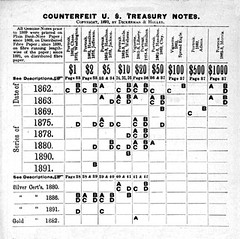 Nearly two years ago in this column, we exposed the cycle of wild-eyed fibbery concerning the amount of counterfeiting prevalent in this country during the U.S. Civil War.(1)
Nearly two years ago in this column, we exposed the cycle of wild-eyed fibbery concerning the amount of counterfeiting prevalent in this country during the U.S. Civil War.(1)
In doing so, I hoped this column had exposed the "infinite echo chamber of error" surrounding unsubstantiated, grossly over stated, and frankly erroneous views misrepresenting the amount of counterfeiting in the United States in that era. These bogus claims take the form of alleging that one-third or (horrors) even more of the notes in circulation were fake at the time.
In these pages, I tracked these spurious claims back to the U.S. Secret Service published sources. The principle architect of this "big lie" was the self-serving mis-guesstimater-in-chief Col. William P. Wood, first chief of the federal detective bureau charged with eradicating the scourge of bogus bills. Wood attempted to mitigate his dismal failure to suppress rampant counterfeiting by outrageously claiming the problem he inherited was much, much worse than it in fact was.
As we have shown over many months, Wood is a spectacularly unreliable witness in this or any regard. This fake "colonel," who had no discernible success in reducing the output of the midnight pressmen, was a self-serving liar on this as on many other things. However, Wood's falsehood took on a life of its own, and has echoed down to the present day infecting the works of nearly all writers on this subject.
If you want a refresher, read this columnist's August 2009 column, Part 50 in this series, titled "Who is responsible for the misinformation?" which appeared in Bank Note Reporter on pps. 42-47. If you don't have the hard copy of the essay handy, it is archived on this publisher's excellent numismaster.com website at www.numismaster.com/ta/numis/Article.jsp?ad=article&ArticleId=7023. It covers the source of this bad data and the resultant cascade of copycat "wolf criers" across the publishing industry, and more recently on the Internet. I followed this hogwash time after time in print and on the Internet, until I tired of the exercise tracking down all the permutations of these lies.
Many similar deceits cropped up in otherwise reputable official government or scholarly sources, and in the mass media like the Washington Post and New York Times. The erroneous one-third counterfeit claim virus even infected the Public Broadcasting Service's "History Detectives" television series.
I hardly expected various government bureaucrats, nor the many data aggregators, bloggers, or other information lightweights to respond to my arguments, or change their erroneous claims. It was too much to hope that these misinformers would even acknowledge that their fraudulent claims had been called into question. Once a falsity becomes an idée fixe (a fixed notion, i.e., a delusional idea that dominates the mental frame over a prolonged period, such as a mental disorder) it is impossible (or at least very difficult) to disabuse the percipient of his/her error.
To read the complete article, see: Tall Tales Die Hard, or the Big Lie (www.numismaster.com/ta/numis/Article.jsp?ad=article&ArticleId=20948)
MORE ON AMERICAN COINS IN THE SHORTHOUSE COLLECTION
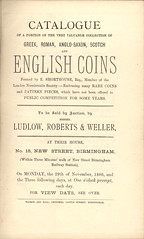 Mr Shorthouse made some interesting comments. Having held this sale in Birmingham, rather than London, and not being too happy with the result, he decided not to try that route again. When he sold a collection of US coins in 1889, he requested the Chapman Bros. to sell the coins in New York City, rather than Philadelphia.
Mr Shorthouse made some interesting comments. Having held this sale in Birmingham, rather than London, and not being too happy with the result, he decided not to try that route again. When he sold a collection of US coins in 1889, he requested the Chapman Bros. to sell the coins in New York City, rather than Philadelphia.
The Shorthouse post sale "Blog" was not new to me. It appeared in a 19th century periodical. It may have been a Ebenezer Mason publication. He states that the prices of US coins in England have doubled in the last five years, then states that Dr Clay's coins sold for a mere song in NYC. However, that sale was held more than 10 years previous.
Speaking of the Clay sale, I can not speak of the British coins, but I always thought the US coins brought rather good prices for the time. (This despite the "sour grapes" statements of Mason, whose bid to buy the collection en-bloc was rejected.)
Under the paragraph titled PLUMS, which describes The Shorthouse US collection, most of these coins were sold in the 1889 New York sale. Here are some of the prices realized:
Cents, 1793 Ameri $85, 1795 lettered edge $40, 1796 $63, Nine other 1793's $6.50-$17, 1794's $1.35- $10,1804 $17& $10.50,Half cents 1793 $12&$10, the 1796 was not offered. Colonials, NE shiling $30, 1659 Md shilling $30,NY 1787 Indian standing $126. Dime 1796 $10, Quarter 1796 $40. Canada 1838&1839 side view tokens $33&$24,Pitt,no stamps $25.
He concludes with the statement that American coins are the most uninteresting in the world. However, I would wager that he was quite happy to receive the fat check for the results of his 1889 sale.
To read the earlier E-Sylum article, see: AMERICAN COINS IN THE SHORTHOUSE COLLECTION (www.coinbooks.org/club_nbs_esylum_v14n23.html#article12)
ARTICLE SPOTLIGHTS THE U.S. MINT'S CITIZENS COINAGE ADVISORY COMMITTEE
"I have a problem with the proportion," says Heidi Wastweet, examining a slide projection that depicts a soldier on the march. The arms are too short, she says. "It doesn't look like a real, human gesture."
We are in a standard, gray conference room at the U.S. Mint's downtown offices. We are here with the Citizens Coinage Advisory Committee, the people whose job it is to debate how your money looks.
There are 11 people on the CCAC. By law, one member must be specially qualified in numismatics, which is the study or collection of currency, and another on numismatic curating. One must be an expert in medallic arts, one an American historian. Four are recommended by the House and Senate leaders.
The remaining three are members of the General Public, the Everymen of the committee, the ordinary citizens who are called forth to proudly serve their country's coinage.
Should the new penny's reverse show a Union shield with a laurel wreath, or a Union shield with a quill pen and saber, or an eagle carrying a Union shield, or should it show an American flag? On his one-dollar presidential coin, should Chester Arthur's hair be combed or sheepdoggy?
These are the concerns of the CCAC.
Right now the committee is discussing options for a commemorative coin honoring the U.S. Army Infantry.
To read the complete article, see:
The U.S. Mint's Citizens Coinage Advisory Committee: They don't just flip a coin
(www.washingtonpost.com/lifestyle/style/the-us-mints-citizens-coinage
-advisory-committee-they-dont-just-flip-a-coin/2011/05/26/AGlDfjFH_story.html)
BUCKET LISTS FOR COIN COLLECTORS
Parade magazine published an article that listed a "bucket list" for Americans to do this summer. A "bucket list" I learned is a wish list of things to do before one kicks the bucket. Could coin collectors have such a "bucket list?" Not only could they, but it could be divided into two divisions, for newer and senior collectors.
A Bucket List for New Collectors.
1. Join a coin club if you haven't already. Ask around for meeting details. Your local coin dealer would know even if he doesn't attend.
2. Join the ANA. That's the national organization. Find their web site on the internet at money.org.
3. Subscribe to a coin publication. Feel free to buy from the ads, the publications monitor their advertisers to keep out bad guys.
4. Buy a book. In fact buy several, the more you know the more fun and knowledge you will possess.
5. Google the name of a coin, or a coin type and see what you find. Lots of info on line, be skeptical, however, lots of misinformation online as well.
6. If you are collecting one denomination only, try another.
7. Hey, try collecting coins of another country. There are dealers who specialize in foreign coins. Check out the ads in the coin publications.
8. If you have a set of coins in an album, buy a more expensive album and transfer the coins. Handling them again is a pleasure, you will enjoy viewing both sides again and will appreciate the more attractive album..
9. If you have collected only coins, try other numismatic items -- tokens, medals, paper money, odd and curious. It's a big field. Collect something new.
10. Jump into the Senior list for one of the items listed there.
A Bucket List for Seasoned Collectors.
1. Try a new specialty. Medal collectors have as many as six specialties at any one time. New items to acquire don't come on the market all that often, so they need to work on several at once.
2. Photograph your collection. First obtain a "light box." Lay the item on that, turn on the light and shoot. This method removes all background image. You have only the image of the item. That's ideal. Create a computer file of those photo images.
3. Catalog what you have collected. Develop your skill in describing each item. Make a checklist of every datum you could ideally identify about each item and attempt to find that information. Merge the two, put the descriptions you have written under the photo of the item. It's easy on the computer.
4. Do some research. Hit the libraries. What information are you lacking or would like to know about what you own or other items in your specialized topic? The information is out there but it may take a lot of digging to find it. Ask questions. From librarians, curators, other collectors.
5. Write a speech or article on your specialized knowledge of that specialty. Clubs welcome speakers on interesting numismatic subjects. Likewise publications welcome articles.
6. Join with other collectors of your topic or specialty. In addition to the camaraderie, the larger the number of interested collectors the greater the sales potential for your collection when you go to sell it, or your estate disposes of it.
7. Acquire a die (or a pair). It will give you tremendous insight how coins, medals, tokens are struck.
8. Attend an ANA Summer Seminar. Dozens of subjects available. Pick one and spend a couple weeks in Colorado Springs.
9. Travel to a national or international numismatic convention. It's days of pure numismatic pleasure. Meet new people. View some new material. Purchase something new to remember the event by.
10. Make plans for the disposition of your collection. Sell, auction or donate? Who to sell or auction? Who to donate, are you sure they will accept it?
Good Luck.
THE '76 GOLDWATER DIME - COLLECTING COINS OF ALTERNATE UNIVERSES
Chris Fuccione writes:
I recently heard this audio short story "The '76 Goldwater Dime" by John Medaille. It is a story of someone who collects coins from different alternate universes. It is from the Escape Pod podcast. I thought this might be a good discussion points of some "what ifs".
When I was just seventeen I moved by myself down to Washington, DC, cause I got a job there in a coin shop. That was my education. I lived in a one room dungeon in a crumby neighborhood, I loved coins that much.
You know, and I do alright. I made my living. I own my own house. I don't live in debt like everybody else does. That's what coins did for me. Coins and specie and spec. I don't care for paper money, it holds nothing for me.
Me, I'm a specialist. I know generalists, I do business with them, I have to. And speculators, sure. You do what you need to do to survive in the world. But me, I'm a specialist and my friends are specialists. I'll give an example, I have a friend, he died. But before he died, his specialty was pay toilet tokens. I mean, have you ever seen a pay toilet? In your life? I saw some once in Europe but I don't even know if they have them there anymore. Anyway, this friend of mine, he spends his life collecting these tokens, these coins, for pay toilets, from around the world and every age. He finds the obscurest pay toilet tokens there are and they're his. And then he dies alone in his apartment with these thousands of toilet tokens around him. I mean, that's the way to go. I mean that. To have these objects of joy around you. To you and me, they are not objects of joy, but to him they are. You know, not everybody gets to have that, it's not something that everyone receives. To have such pleasure from these things, these old things. But he does and I do because, see, we're specialists. Not everybody understands that.
Other people I know, you know, have their special collections. Any thing you can think of, any given thing and there's some guy like me out there obsessed with it. I know people, you meet a lot of interesting people in this business, whose specialties are Depression era wooden nickels or peep show tokens, or misprint coins, error coins, or brockage, that's coins with mirror image stamps on both sides, or obverses or ‘Godless Dollars.' You ever heard of ‘Godless Dollars?' Those are dollar coins where the "In God we trust" part got left off. Now, you see, I respect that. Those are people with specialties. They are connoisseurs, like me. Not any old crap will do.
My specialty? My specialty is the rarest of the rare, okay? I mean, I have collections and I have collections, but my real collection, the only one that's not for sale, that's not in the vault, I'm not even going to tell you where I keep it, guess how many coins I have in my collection. Guess.
I have twelve coins in my collection. That's twelve. I've been doing this for coming up on fifty years and I've amassed twelve coins. In my specialty collection. Now you understand my mind.
I brought them here, I got them in my fireproof, waterproof, idiotproof box, just for you. I brought them to show you because I happen to know you will not shoot me and stab me thirty-six times and run off with my pretty little coins. Besides, I paid more money for the lockbox than I paid for all the coins. So, that's where we are. So allow me to reveal to you, at long last, my specialty.
Okay, this is item number one, this is Exhibit A, okay? I got this in 1981 in my change for a fish sandwich, I kid you not. Don't smudge it. It's mint. It's pristine. It's almost uncirculated, but in another way, it's very, extremely circulated. First, before I give this to you, tell me, who's on the dime?
Very good, FDR's on the dime. Has been since 1946. Now look at this and tell me, who's on that dime?
Yes, he's wearing glasses. FDR wore glasses too but not when posing for coinage. Who is he? No, it's not Truman. Look closer. Recognize him? That's Barry Goldwater. Look, that's him. Yes, I am fully aware that Goldwater was never president. Thank you, Mr. Historian. But that is him and that is a 1976 dime and he's on it. Now you see. Now you see my specialty.
Okay, okay. Let's forget that for now. Let's move to exhibit number two. Take this. Yes, this is a '72 Kennedy half dollar. Yes, that's Kennedy on it. But look at that face, look how wrinkly he is. No, that's not wear, that's not metal fatigue. Metal doesn't wear like that, believe me, I know. That's in the stamp. Which Kennedy is that? That's not John F Kennedy, that's Joseph P Kennedy, his father. Look at it. Sure, he ran for president. An anti-Semite, that's what they said. I'm not going to argue about it now. Give it back. Okay, item three: 1927 penny, Lincoln's supposed to be on it, but who's that guy? Look at that beard. That's John Brown. Number four, 1944 quarter, that guy on it? Eugene V Debs, that commie guy that run for president in 1900. Can you imagine America with a commie president?
Okay, hell with it, look at the rest here:
Huey Long nickel, 1958.
William Randolph Hearst silver dollar, 1969.
Robert E Lee three cent piece from 1888. Don't be stupid, there was no confederate money in 1888.
1965 dime, that's Lindbergh on it.
1992 quarter, you know who that guy is on there? Roy Cohn. Took me forever to figure that one out.
1935 penny, Barnum, the circus guy. That one might actually be a forgery, the zinc plating, it's a little off. Anyway.
1986 nickel, got Herbert Hoover on it. One of the most hated presidents of all time, how'd he get on the nickel?
And lastly, okay, look that this, this is the prize of my collection, 1998 quarter. Who's on it instead of Washington? That's Benedict Arnold. I swear before all that is holy. You know, that son of a bitch was a war hero before he turned traitor.
So that's it. That's my entire collection right there. Nothing else to show. This is my specialty. You see here my life.
To access the podcast, see: EP286 The '76 Goldwater Dime (escapepod.org/2011/03/31/ep284-the-76-goldwater-dime/)
FEATURED WEB SITE: FRENCH BANKNOTES
This week's Featured Web Site on French Banknotes is suggested by Martin Kaplan. Thanks!.The banknotes designed by French artists and printed by Banque de France are in my opinion the most beautiful notes from the 20th century. The subject matter, striking colors, and a wonderful quality of engraving and printing make them immediately recognizable. Not only were these notes printed for use in France, but they were also printed for the French community and other countries as well.
Displayed here is a collection of France proper, virtually all of which were designed by French artists and printed by the Bank of France.
There is also a collection of French inspired banknotes used in the greater French community. My use of the phrase "French inspired banknotes" on this site is intended to include notes printed in France, or notes designed by French artists.
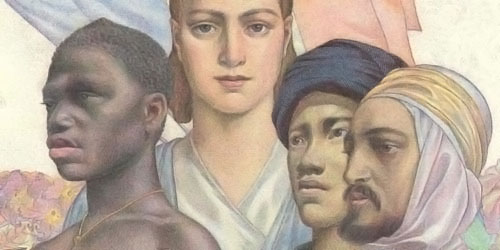
www.frenchbanknotes.com
